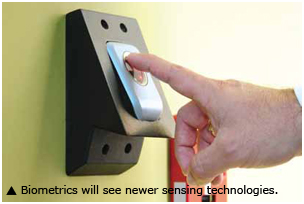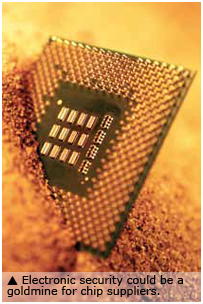As 2010 ends on a high note, optimism is high for 2011. A&S talks to research analysts,manufacturers and channel players to find out what’s next in the year to come.
As 2010 ends on a high note, optimism is high for 2011. A&S talks to research analysts, manufacturers and channel players to find out what's next in the year to come.
The financial crisis shook up physical security, eliminating unfit players. A “recessionproof” industry took a hard look at itself and emerged stronger. Manufacturers had to explain to buyers the additional benefits of their solutions, making value the spec to beat.
Consolidation is expected to continue in 2011. “We expect that 2011 will set a new record for mergers and acquisitions, but the rate of growth in consolidation will fall off,” said Allan McHale, Director of Memoori. “Most of the major security companies, including Honeywell Security, Schneider Electric, Siemens Building Technologies, Johnson Controls, Bosch Security Systems and UTC Fire & Security, have yet to seal a deal in 2010, and it is most unlikely that they will be able to resist the temptation in 2011. The main driver will continue to be IT convergence, combined with the fact that major companies have strong cash reserves and venture capitalists want to realize their investments.”
Open Standards
Standards offer customers more choices for best-of-breed solutions and spare manufacturers the hassle of individual third-party integrations. The value proposition for standards will keep going strong in 2011. “While both ONVIF and PSIA have made good progress in gaining equipment vendor support, the topic of standards in network video surveillance is still very young, and it is unlikely that standards will have any sudden impact on the video surveillance market,” said Gary Wong, Senior Research Analyst for Video Surveillance and VCA, IMS Research. “However, the eventual adoption of open standards will force video surveillance equipment vendors to increasingly focus on differentiating themselves from competitors.”
By the numbers, ONVIF has greater uptake, with more than 220 members and 389 compliant products as of November. PSIA has been around longer but is supported on 63 products, a fraction of ONVIF's offerings. “PSIA stands out because it is focused on developing IP standards for all technology sectors,” said David Bunzel, Executive Director of PSIA. “This includes video surveillance, access control, video analytics, recording and software management platforms, and storage devices.” PSIA released its video analytics specification in September 2010, with an access control specification to follow in the coming months. “This eases complex installations for integrators and enables end users to choose the best solutions that meet their security needs,” he said.
Several vendors have solutions compliant with both standards. “We're firm believers in standards,” said Jumbi Edulbehram, VP of Business Development, Next Level Security Systems. “Our products support ONVIF and PSIA, the two main standards for network-based security systems.”
Another vendor with solutions conforming to both bodies is Hikvision. “Currently, there have been substantial requests to manufacture products that support both ONVIF and PSIA standards,” said Tony Yang, International Marketing Director at Hikvision Digital Technology. “Products that embrace both the analog and IP technologies, the hybrid products, are also in demand.”
Honeywell has its own Open Technology Alliance, with increased third-party cooperation and support for PSIA and ONVIF. “We are members of both organizations, and our intent is to have all of our systems — NVRs and DVRs — support both standards and to offer edge devices like cameras in one or the other standard,” said Johnny Allia, VP and GM for EMEA, Honeywell Security.
 With the varying levels of uptake, some vendors are taking a wait-and-see approach to make sure they embrace the right standard. “If standards are updated, this will make integration easier,” said Herve Fages, Global Marketing Director for Pelco (a Schneider Electric company). “Pelco is looking at different standards. Customers are asking for better and easier integration.”
With the varying levels of uptake, some vendors are taking a wait-and-see approach to make sure they embrace the right standard. “If standards are updated, this will make integration easier,” said Herve Fages, Global Marketing Director for Pelco (a Schneider Electric company). “Pelco is looking at different standards. Customers are asking for better and easier integration.”
Another video alliance to emerge is HDcctv. “2011 will represent the first full year of HDcctv equipment sales, and IMS believes that the initial adoption of HDcctv equipment will be low,” Wong said. “While the initial increase in camera cost from SD to HD is likely to be marginal, the cost of HDcctv DVRs are expected to be significantly higher than their SD counterparts until economy of scale can be achieved.”
As IP is expected to reach its tipping point (by sales volume) by 2013 or 2014, there are doubts about the longevity of HDcctv. “HDcctv is a niche market for specialty analog CCTV installations,” Edulbehram said. “We will not support this initiative since we fully embrace the cost savings that IP convergence systems enable.” Next Level is working on cost-effective products for smaller facilities as well as enterprise systems.
 However, some product makers believe that HDcctv will gain market position and status. “Contrary to market predictions, like reports published by IMS, I believe that analog products will continue to dominate the market in the years to come,” said Craig Scott, CEO of OVii.
However, some product makers believe that HDcctv will gain market position and status. “Contrary to market predictions, like reports published by IMS, I believe that analog products will continue to dominate the market in the years to come,” said Craig Scott, CEO of OVii.
Integration
The credit crunch squeezed buyer wallets and put pressure on solution providers to diversify their portfolios. Even traditional access control players, such as Nedap, added VMS functionality to their controller management solutions.
Schneider Electric branched into the cloud, as Pelco has expanded compliance for IP-enabled products on US government networks. While Pelco has an impressive hardware lineup, networking and integration are the way forward. “We're seeing the first change, switching from analog to IP,” Fages said. “The next step is to have HD. Then the next step is cloud computing, cloud recording and cloud management, which will change the industry.”
 VMS is expected to move beyond managing video systems alone. “In 2011, IMS expects to see vendors place an increasing emphasis on verticalization, creating verticalspecific solutions,” Wong said. “For ‘open-platform' VMS vendors, while the horizon for instant interoperability among all types of network video equipment is still far away, 2011 should see vendors of VMS begin to focus on developing more innovative solutions.”
VMS is expected to move beyond managing video systems alone. “In 2011, IMS expects to see vendors place an increasing emphasis on verticalization, creating verticalspecific solutions,” Wong said. “For ‘open-platform' VMS vendors, while the horizon for instant interoperability among all types of network video equipment is still far away, 2011 should see vendors of VMS begin to focus on developing more innovative solutions.”
Solutions are the way forward. “In 2011, we will continue to expand our line with innovative offerings,” said Daniel Gundlach, VP of Marketing for the Americas, Bosch Security Systems. “Specifically, the market will see new products that provide a full solution for HD video and enhancements to our control panels for intrusion, fire and access control.”
Video surveillance or managed video as a service has emerged as alternative business models, with everyone from new companies to channel partners and ISPs eyeing this space. More managed video offerings will be ahead in 2011.
No - Frills Video
Top-shelf video manufacturers have launched budget cameras for basic surveillance needs. Sony released its affordable HD line this year, with fewer lens choices and no IR. This marks a departure from adding more features to a more practical solution for a general range of applications.
 “There's increasing demand for security systems to be user-friendly — easy to set up, easy to configure, easy to use,” said Daniel Ong, VP of Certis Technology International, Certis Cisco Security. “The challenge is to achieve user friendliness without compromising the security and integrity of the systems. With the increasing popularity of IP-based systems and edge devices, customers are also expecting security cameras, DVRs and access control systems to be ‘plug-and-play' with minimum setup and configuration required.”
“There's increasing demand for security systems to be user-friendly — easy to set up, easy to configure, easy to use,” said Daniel Ong, VP of Certis Technology International, Certis Cisco Security. “The challenge is to achieve user friendliness without compromising the security and integrity of the systems. With the increasing popularity of IP-based systems and edge devices, customers are also expecting security cameras, DVRs and access control systems to be ‘plug-and-play' with minimum setup and configuration required.”
Some solutions have automatic configurations of network video streams for easy setup. “For our product development road map, Cisco announced the industry's first medianet-enabled network camera that provides simplified plug-and-play configuration with medianet-enabled Ethernet switch ports,” said Lindsay Hiebert, Marketing Manager for Cisco Systems.
Regional preferences should be accounted for. “We've recognized the need to design products for the local market,” said Mark VanDover, President of Tyco Security Products. “We address the price needs.”
 Storage
Storage
Breakthroughs in networking, storage and compression technologies are driving growth in the network storage market. “The increase in the number of video channels per installation and the resolution of the cameras are some of the primary reasons for the growth of data in video surveillance applications,” according to Frost & Sullivan's report on the North American physical security network storage market.
Network storage, in particular IP storage area networks, is at the forefront of new enterprise surveillance projects. IMS's report, “The World Market for Enterprise and IP Storage used for Video Surveillance,” forecasts network storage will account for more than 30 percent of world video surveillance storage revenues in 2013, which are likely to exceed US$5.6 billion by then.
Better storage and cloud options will benefit end users. “More storage capacity and faster computing resources will be delivered as hardware in standard servers increases,” said Lee Caswell, founder and CMO, Pivot3. “We will pass these improvements along to our customers as they become available in the marketplace.”
 Components Semiconductors form the innards of security devices, making physical security a potential goldmine for component suppliers. In-Stat forecast revenue from analog cameras, network cameras, DVRs, NVRs and encoders will reach $19 billion in 2011. However, image sensor revenue for surveillance cameras will drop from $700 million in 2008 to $435 million in 2013.
Components Semiconductors form the innards of security devices, making physical security a potential goldmine for component suppliers. In-Stat forecast revenue from analog cameras, network cameras, DVRs, NVRs and encoders will reach $19 billion in 2011. However, image sensor revenue for surveillance cameras will drop from $700 million in 2008 to $435 million in 2013.
Overall semiconductor predictions, which include consumer applications, will grow 8 or 9 percent in 2011, according to IDC. This market upswing is reflected in Intel's investment in NetPosa, a Chinese IP video provider. Its ONVIF-compliant NVRs and servers will be based on Intel architecture and software.
Network camera providers are sensitive to semiconductor supply, as they require sensors and processors, which are rarely made in-house. “We continue to enhance our product quality to enlarge our market share,” said William Ku, Director of Brand Business for VIVOTEK. “That way, we will have stronger bargaining power in component purchases.”
 Access
Access
Growth is ahead for access control. Global smart card shipments are set to grow 11 percent to around 8.5 billion units by 2013, according to RNCOS. Europe will see more transportation rollouts, while the US government will deploy cards for industrial markets.
Standards are welcome in the access control space, enabling large clients spread out over many countries to centralize management, such as access rights. They also can use one platform, rather than multiple clients. “Pacom has become a specialist in managing access control from multiple sites, and we plan to extend this core competence to support third-party systems,” said Johan Lembre, CEO of Pacom Systems. “This is one of the major driving factors why Pacom became one of the first members of ONVIF's access control initiative.”
Biometrics is benefiting from new sensing technologies. “These are good developments, but at the end of the day, they have to provide better performance at an equivalent or lower TCO than alternatives,” said Peter Costa, VP and Business Leader of Global Protection, Honeywell Building Solutions.
 Intrusion and Automation
Intrusion and Automation
Demand for alarms is expected to grow in 2011, which could eclipse 2009 estimates of $2.9 billion, said IMS Research. Home automation is expected to increase as well, with system shipments to approach 2.8 million, according to ABI Research.
Intrusion detection solution providers are launching new technologies. “We plan to substantially broaden our portfolio with panels, detectors, accessories and solutions that answer the needs of different market segments in general and our customers' needs in particular,” said Laila Arad-Allan, VP of Marketing, Visonic. “Our lower-price products are just as reliable, even more so because they are less complex by delivering less features and not less costly components.”
Israeli intrusion provider Risco has expanded its portfolio through strategic purchases of access control and video companies. It now offers remote monitoring in parts of Europe, increasing its revenue beyond product sales.
Homeland Security
The 9/11 bombings had an indelible effect on security, putting terrorism on the list of threats. While no more planes have deliberately hit skyscrapers since then, the ingenuity of criminal minds has yet to be thwarted. The most recent example was November's attempt to send explosives disguised in printer cartridges aboard cargo planes, rigged to detonate remotely. With US cargo screening mandated by the end of 2011, more equipment will be required to keep up with demand.
 Production
Production
As the recession called for cost-cutting measures, some organizations relocated production. While most manufacturers are staying put, they are more open to setting up shop elsewhere. “Despite increasing labor costs in China, the company currently has no plans to relocate its factory elsewhere, although it cannot completely discard the possibility in the future,” Yang said.
Belt-tightening includes eliminating rarely used features to cut cost. “We don't have any plan to move,” said Bruce Wu, Overseas Marketing Director for Dali Technology. Production in China remains advantageous and more flexible.
Other vendors do not plan to outsource labor. “Our products are produced in Taiwan, where labor costs are higher than China,” Ku said. “But we do not plan to relocate our factory outside of Taiwan in 2011.”
Managing personnel effectively can control costs. “Setting up a factory in Taiwan might not be as costly as some might think — it all depends on how people are managed to work to their full potential,” Scott said.
 Automation can decrease costs while improving quality. “Our way of addressing the increasing cost of labor is by implementing more automation in our production,” Arad-Allan said.
Automation can decrease costs while improving quality. “Our way of addressing the increasing cost of labor is by implementing more automation in our production,” Arad-Allan said.
A benefit of local production is closeness to buyers. “While the cost of labor is low, the challenge of managing quality and providing quick response time to critical customers demands that we keep our product development in the U.S. as it is today,” Caswell said.
Locating good partners can reduce cost as well. “For us to remain cost-competitive, we are considering using an OEM for peripheral devices — particularly when the item is already certified for use in countries in which we operate,” Lembre said.
Channel Development
Manufacturers will continue to rely on distributors for their channel in the upcoming year, rather than go to end users. “Our company follows the ‘direct sales, indirect fulfillment' model, which means that our products will be sold exclusively through distribution, but we will have a direct sales relationship with integrators and end users,” Edulbehram said. “That way, we can keep our prices lower by leveraging our distributors' efficiencies, and at the same time, have deep relationships with end customers and integrators for sales and support.”
Pacom also relies on VARs for sales, while networking with end customers and integrators directly. “For us as a manufacturer, the contact with end users is vital as we learn about their challenges and develop innovative and cost-effective ways in which they can overcome their issues,” Lembre said.
 While selling to end customers is effective, it requires significant manpower. VIVOTEK will continue its channel efforts with distributors and system integrators, Ku said. Road shows with solution partners are another way it plans to expand its channel.
While selling to end customers is effective, it requires significant manpower. VIVOTEK will continue its channel efforts with distributors and system integrators, Ku said. Road shows with solution partners are another way it plans to expand its channel.
Channel partners can respond quickly to end-user needs . “Education is always provided in full to solution and channel partners to better prepare and educate users in using our products,” said Ian Cameron, MD of Mirasys.
Strategic partnerships can be an effective go-to-market strategy for specific vertical segments. “We will broaden our channel development toward telcos and utility companies who are interested in combining home security with their offerings and services,” Arad-Allan said.
Dis tributor Brands Distributors and integrators will launch more independent product lines in 2011, as margins and volumes fall. An example was Dutch integrator TKH Group acquiring Optelecom-NKF in November. “The phenomenon of distributors pushing their own brands into the market is not unusual, and Hikvision does not view this as a threatening move for intense competition,” Yang said. “Instead, the company will find ways to cooperate with a wobbling distributor to secure its foothold in the market and seize opportunities together. Even if a distributor asked Hikvision to accept OEM orders, the company would be happy to work together.”
Other product makers also felt distributor brands would not hurt their business. “We will focus on OEM sales for global distributors,” Wu said.
Distributor brands do not always compete with products carried by the distributor. “Even when working with ADI Global Distribution, a subsidiary of Honeywell, in Nordic countries, who have their own branded products, Mirasys continues to acquire good market share,” Cameron said. “In terms of functions, software abilities, scalabilities and interface applications, as long as the product is unique, market competition should not be feared.”
 Marketing and Education
Marketing and Education
As the market rebounds, manufacturers are preparing to reach out to strategic buyers. “Our end users are the installers and central monitoring stations,” Arad-Allan said. “They are in most cases the decision makers of which security system to install in the home.”
Visonic's sales and marketing efforts will target installers with events, dedicated tools, webinars and papers. “Another media we will soon start using is social media, which is an excellent tool for engaging our customers in conversation, ideas, views and information,” Arad-Allan said.
The PSIA will focus on engaging consultants, end user sand integrators. “Over the course of 2011, PSIA will present focused educational offerings in specific regions and online,” Bunzel said. “We will continue to conduct strategic educational outreach to better inform the industry of our efforts.”
VMS is becoming more essential, yet requires training for end customers and channel partners. “We place a lot of emphasis on education, especially because the market is undergoing a transition from analog to IP,” Edulbehram said. “We will certainly use new media tools that are available for education — Web-based training — as well as networking with Facebook, LinkedIn and Twitter.”
Returning to basics, dialogue is essential for manufacturers and solution providers to make customer needs the top priority for 2011. “Focusing on perfecting technical functions might be impressive, but might not suit the needs of the end users,” Scott said. “Build things people want to buy!”